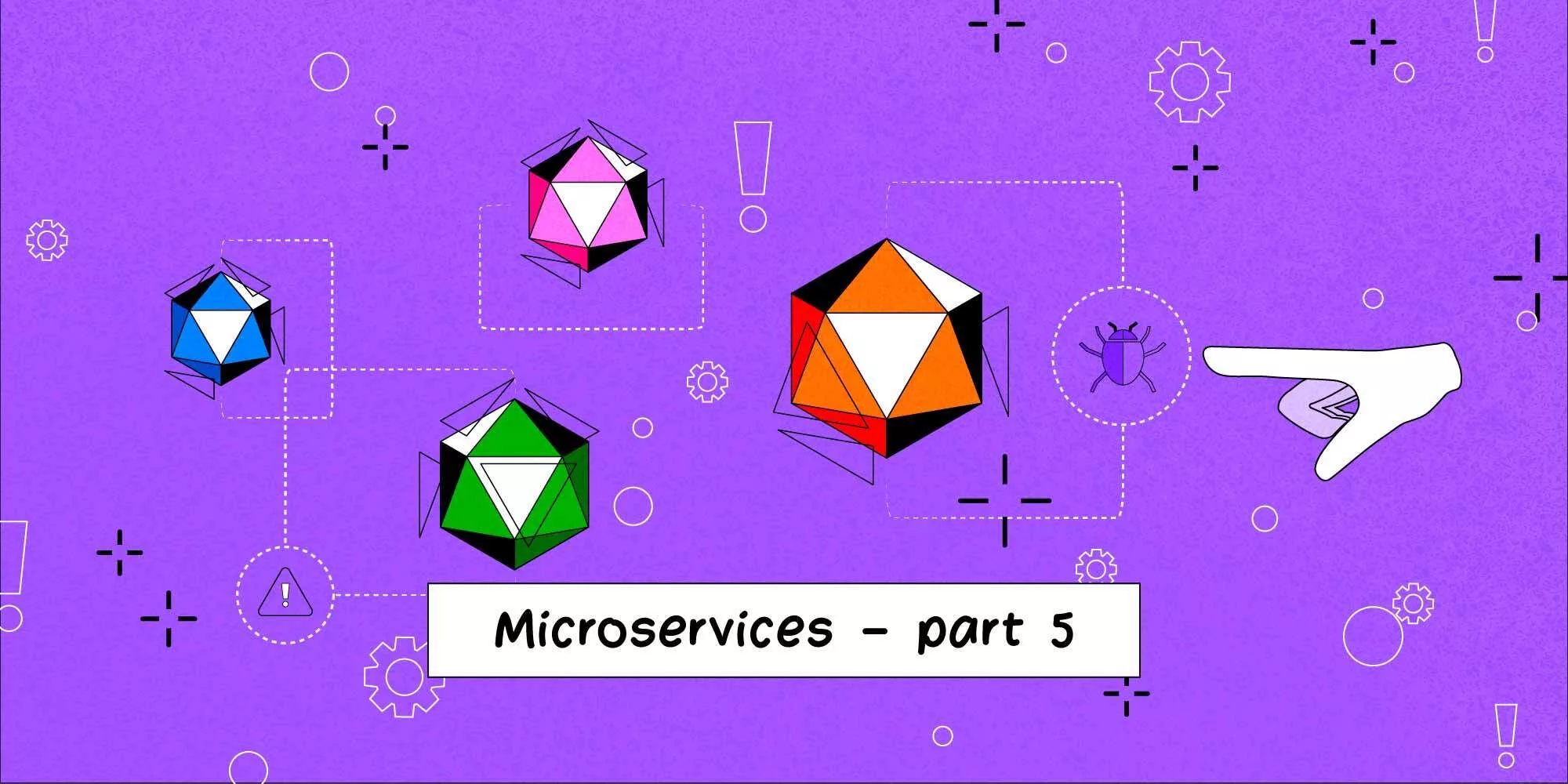In the intricate world of microservices architecture, where systems are composed of small, independent services working together, testing plays a big role in ensuring the quality, reliability, and resilience of the overall system. As we navigate through the final part of our microservices blog series, we delve into the realm of testing. Testing in microservices brings its own set of unique challenges and considerations, requiring specialized approaches and tools to validate the intricate communication and behavior of these distributed components.
In this concluding segment, we explore various aspects of testing within a microservices ecosystem. We’ll dive into different types of tests, ranging from unit testing to end-to-end testing, contract testing to security testing, and more. By understanding and implementing effective testing strategies, you can gain confidence in the stability, performance, and security of your microservices.
Unit Testing
Unit tests are the smallest test we have, testing a single unit. A unit can often be a method or a set of methods working closely together. Our engineer Konsta wrote an excellent blog post about unit tests, which be found here (In Finnish).
In short, By thoroughly testing units in isolation, developers can identify bugs, catch regressions and validate the logic within each microservice. Unit tests enable early detection of issues, promote faster development iterations, and enhance the overall quality and maintainability of microservices-based applications. Furthermore, Unit tests should be cheap to execute and have fewer dependencies than any other tests in our projects.
Integration Testing, or is it?
Integration tests, also known as service tests, are a fundamental aspect of software testing that ensures smooth collaboration and integration among multiple microservices. Unlike unit tests that assess individual units of code, integration tests should evaluate the interactions and dependencies between services. By simulating the behavior of external dependencies using mocks and stubs, these tests more closely replicate real-world scenarios and identify issues that may arise in production environments.
Let’s consider an example where we have an e-commerce application consisting of several services: a product catalog service, a shopping cart service, and a payment service. The integration tests for this scenario would aim to verify that these services communicate correctly and that the overall functionality of the e-commerce system is intact.
To accomplish this, developers employ various techniques, including the use of mocks and stubs. Mocks simulate the behavior of external dependencies, such as a third-party payment gateway, allowing developers to control and verify interactions with these dependencies during testing. Stubs, on the other hand, provide predefined responses to simulate certain service behavior. By utilizing mocks and stubs, integration tests can replicate real-world scenarios, even if certain dependencies or services are unavailable during testing.
For our e-commerce example, an integration test might involve simulating the flow of adding products to a shopping cart, proceeding to the checkout process, and verifying that the payment service is appropriately invoked to complete the transaction. The integration test would validate that all services are interacting correctly, that the necessary data is passed between them accurately, and that the expected outcomes are achieved.
Most often Integration tests are written so that we test a single service at a time, mocking the other services to isolate the single service for faster testing and easier CI/CD processes, where a pipeline does not have to spin up multiple services for every new push.
It’s important to note that while integration tests with mocks and stubs may not replicate the exact behavior of real services, they provide a valuable alternative in situations where fully spinning up all services for comprehensive integration testing is complex or impractical. By employing these techniques, developers can identify and address issues related to service communication, data inconsistencies, and the overall integration of microservices. To ensure the data between two or more services are as expected, we can utilize contract tests.
Contract Testing
Contract testing is a valuable technique used to ensure effective communication and integration between microservices. Contracts define the data structures and APIs that should be used to communicate between services, and contract tests verify that these specifications are being met. By employing contract testing, developers can validate that their microservices interact correctly and produce the expected results.
Let’s revisit our e-commerce example with the product catalog service, shopping cart service, and payment service. In this context, contract testing would involve defining the expected interactions and data exchange between these services. For instance, the contract might specify that the product catalog service should provide a list of available products, the shopping cart service should be able to add items to the cart, and the payment service should handle the payment process.
To conduct contract testing, developers would define the contract and create tests to verify that each service adheres to its obligations. For example, a contract test for the shopping cart service would ensure that it correctly consumes the product catalog service’s API to fetch available products and that it properly formats and sends requests to the payment service.
By employing contract testing in our e-commerce example, developers can identify any inconsistencies or compatibility issues between services early on. For instance, if a change in the product catalog service’s API breaks the expected contract, the contract tests would fail, highlighting the need for communication and resolution among the service teams.
A popular tool for contract testing is Pact. Using Pact, developers can define and manage contracts, generate contract tests, and execute them to validate the compliance of each service. Pact facilitates consumer-driven contract testing, where the consumer of a service defines the contract, ensuring that the service meets the expected behavior.
By incorporating contract testing into the testing strategy, developers can ensure that their microservices communicate effectively and efficiently. It helps minimize integration issues and promotes seamless collaboration among the services in the overall system.
In summary, contract testing is a crucial aspect of testing microservices-based applications. By defining contracts and conducting tests to validate service interactions, developers can ensure that their microservices communicate correctly, maintain compatibility, and deliver the expected results. Contract testing, exemplified in our e-commerce scenario, helps reduce integration issues and promotes effective collaboration between microservices.
End-to-End Testing
End-to-end testing, the true Integration test?
In the context of our e-commerce example, end-to-end testing involves testing the complete flow of data and interactions across the product catalog service, shopping cart service, and payment service. These tests simulate real user scenarios, from adding items to the cart to completing the payment, to ensure that the entire system functions correctly.
End-to-end tests provide a comprehensive assessment of the system’s functionality, ensuring that all microservices collaborate seamlessly and produce the desired results. They validate the integration between services in a production-like environment and instill confidence in the system’s overall performance.
It’s important to note that end-to-end tests can be time-consuming and challenging to set up, as they require a complete and functioning system environment. Therefore, they are typically executed as a final step in the testing process, serving as a validation of the system’s integrity before deployment.
While end-to-end testing offers valuable insights into the system as a whole, it may not be the most efficient approach for testing individual units or small components. Instead, it serves as a critical assurance step to verify that the integrated microservices function correctly and deliver the intended user experience.
Several tools are commonly used to conduct end-to-end tests in a microservices environment. Here are a few notable examples:
- Selenium: Selenium is a popular open-source framework for automating web browsers. It enables end-to-end testing by interacting with web elements, simulating user actions, and validating expected outcomes.
- Cypress: Cypress is a JavaScript-based end-to-end testing framework that specializes in testing web applications. It offers a rich set of features, including real-time reloading, automatic waiting, and easy debugging, making it a powerful tool for end-to-end testing.
- Puppeteer: Puppeteer is a Node.js library that provides a high-level API for controlling headless Chrome or Chromium browsers. It allows developers to automate browser actions, capture screenshots, and generate PDFs, facilitating end-to-end testing of web applications.
- TestCafe: TestCafe is a cross-browser testing tool that supports end-to-end testing for web applications. It provides an easy-to-use API, automatically handles multiple browsers, and allows for parallel test execution, making it suitable for comprehensive testing across different environments.
- Appium: Appium is an open-source framework for automating mobile applications. It supports end-to-end testing of native, hybrid, and mobile web apps across iOS and Android platforms, making it an essential tool for mobile application testing.
- Postman: While primarily known for API testing, Postman can also be used for end-to-end testing by simulating API interactions and validating responses. It offers a user-friendly interface, supports scripting, and allows for easy collaboration among team members.
In summary, end-to-end testing ensures that the entire system, encompassing all microservices, behaves as expected and meets user requirements. By simulating real-world scenarios, these tests validate the complete flow of data and interactions, providing confidence in the system’s functionality and readiness for deployment.
Performance Testing
Performance testing is a type of testing that evaluates the performance, scalability, and reliability of a microservices-based application. Performance testing involves simulating a realistic workload and stress-testing the microservices to identify bottlenecks, measure response times, and assess the system’s ability to handle increased loads. Tools and frameworks such as Apache JMeter, Gatling, and Locust can be used for performance testing in microservices architectures. Monitoring and analyzing performance metrics during load testing is also an important aspect of performance testing.
Each of these tools has its own strengths and weaknesses, and the choice of tool will depend on the specific requirements and constraints of the project. It’s important to select a tool that can handle the desired workload and provide accurate and actionable performance metrics.
Security testing
Security testing is a type of testing that focuses on identifying vulnerabilities and ensuring secure microservices. Security testing techniques include testing authentication, authorization, input validation, and data protection. There are tools and frameworks available for security testing in microservices architectures, and it’s important to incorporate security testing into the development and deployment pipeline to ensure that security issues are identified and addressed early on in the process.
In addition to identifying vulnerabilities, security testing can also help ensure regulatory compliance and protect against data breaches. With the increasing number of cyber threats and attacks, it’s important to prioritize security testing as a critical aspect of any microservices-based application.
When conducting security testing, it’s important to consider the various types of security threats that microservices are susceptible to, such as cross-site scripting (XSS), SQL injection, and cross-site request forgery (CSRF). By understanding these threats and employing appropriate security testing techniques, developers can ensure that their microservices are secure and resilient.
There are several tools and frameworks available for security testing in microservices architectures, including OWASP ZAP, Burp Suite, and Nessus, to name a few. These tools can help identify vulnerabilities and provide actionable insights for improving security.
Other Tests
There are many other aspects of testing, here are a few honorable mentions:
Canary Testing
Canary testing is a technique used to minimize the risk of deploying new code to production environments. By deploying new code to a small subset of users or servers, developers can test the code in a real-world scenario without affecting the entire system. Canary testing helps identify any issues or bugs that may arise from the new code and allows developers to roll back the changes if necessary.
Blue-Green Deployments
Blue-green deployments are a technique used to minimize downtime and risk during the deployment of new code to production environments. By maintaining two identical environments, one active (blue) and one inactive (green), developers can deploy new code to the inactive environment and test it thoroughly before switching the active environment to the new code. Blue-green deployments help ensure that the system is always available and that any issues with the new code are identified and resolved before the switch is made.
Observability and Monitoring Testing
Observability and monitoring are critical aspects of testing in a microservices ecosystem. By collecting and analyzing logs, metrics, and traces during testing, developers can identify and troubleshoot issues before they impact the system. Observability and monitoring tools such as Prometheus, Grafana, and Jaeger can be used to collect and analyze data during testing. Incorporating testing-related telemetry into overall observability practices can help ensure that the system is reliable and resilient.
Summary
Testing plays a crucial role in ensuring the quality, reliability, and resilience of microservices-based applications. This blog post explored various aspects of testing within a microservices ecosystem, including unit testing, integration testing, contract testing, end-to-end testing, performance testing, security testing, and other testing techniques such as canary testing and blue-green deployments. By understanding and implementing effective testing strategies, developers can gain confidence in the stability, performance, and security of their microservices-based applications.
Some additional important points about testing in a microservices ecosystem include:
- Developers should aim to test their microservices in isolation as much as possible. This helps identify bugs and logic issues within each microservice early on.
- Integration testing is a crucial aspect of software testing that ensures the proper collaboration and integration of microservices. By simulating real-world scenarios and identifying potential issues early on, developers can create reliable and cohesive systems.
- Contract testing can be employed to facilitate testing communication between services. It helps to verify the expected data and aids in testing the communication and integration between services.
- End-to-end testing provides a comprehensive view of the system by testing the flow of data and interactions between microservices in a production-like environment. These tests simulate real user scenarios and provide confidence that the system as a whole is functioning correctly.
- Performance testing evaluates the performance, scalability, and reliability of a microservices-based application. It involves simulating a realistic workload and stress-testing the microservices to identify bottlenecks and measure response times.
- Security testing is a type of testing that focuses on identifying vulnerabilities and ensuring secure microservices. Security testing techniques include testing authentication, authorization, input validation, and data protection.
- Other important aspects of testing in a microservices ecosystem include canary testing, blue-green deployments, and observability and monitoring.
By incorporating these testing techniques and strategies into their development and deployment pipelines, developers can ensure that their microservices-based applications are reliable, scalable, and secure.
Postface
Thanks for reading through one or more of my microservice blog posts. It has been a journey and even I have learned a ton! We started going through the basics of microservices, then looked through how the ensure good communication between services. We touched on the topic of monitoring and observability and how important security is in software development. We ended with a long post about testing.
However, as I am only one person I cannot cover everything. Did I miss anything? Is there something that you think is still uncovered, in the world of microservices? I would love to hear from you.
Part 1: The Pros and Cons of Microservices: Is It Right for Your Project?
Part 2: Building a Robust Microservice Architecture: Understanding Communication Patterns
Part 3: The Importance of Monitoring and Observability in Microservice Architecture
Part 4: Securing a Microservice Architecture – 5 Pillars
Part 5: Testing in Microservices: Ensuring Quality and Reliability





